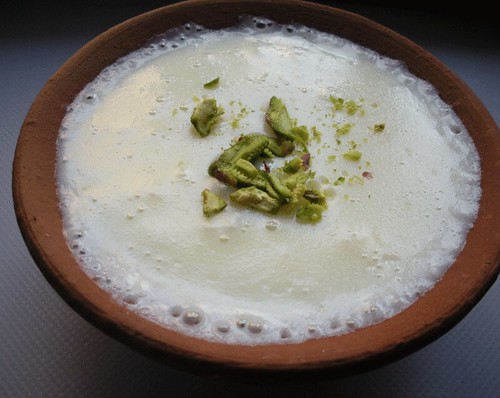Before reading this month's book club pick, I had a vague impression of Madhur Jaffrey as an overindulgent diva who makes Indian food sound "too easy". After reading "Climbing the Mango Trees", the memoirs of her growing up years in India, I know why. The memoirs talk less of her childhood in an affluent joint family, and more of the foods she ate. There's daulat ki chaat and paranthey wali gali. There's kulfi and achaar and chaat from the streets. But all these poigant Delhi memories are also spiked with picnic lunches, and dinners with western influence far ahead of it's times.
Loosely written, the memoirs don't really follow a pattern. It's like a hastily scribbled diary, where Madhur writes whatever strikes her that day. I think the book is more charming because of that.
Madhur ends the book with a collection of her family recipes. From her fondly remembered dishes, I picked one of my memories - phirni, the custard-like pudding made with powdered rice.
Step one of making phirni was finding a shallow earthenware dish. That's what I've always eaten phirni in back home and I didn't want it any other way. I didn't spot the dishes for sale anywhere, but I spotted my milkman selling curd in those. And the sweet uncleji happily parted with two dishes I could set my phirni in.
Making phirni itself is easy. I followed Madhur's directions and mixed 2 1/2 tsp of rice flour with 2 tbsp milk to form a paste. Then I brought 230 ml milk to a boil with 2 tbsp sugar. Took it off the heat as soon as it was boiling. Poured it on the rice paste and whisked until it was smooth, the rice completely mixed in. Then returned the milk to the stove and simmered for around 10 minutes. This part is tricky; you have to constantly whisk the milk or you will get clumps of rice in your phirni. Once the custard thickened, I poured it into my two treasured dishes and let it cool at bit. Then sprinkled pistachios and let is chill. Phirni tastes best when cold.
Here's what other book club members came up with:
Janaki made Palak Gosht.
Sheba made Cauliflower with Cheese.
Sweatha made Roz Ki Gobhi.
Jaya made bazar jaisey aloo.
Aqua made Tahiri.
Also, do stop by to read Ann's very interesting story about the book!
Next month, we are reading "Under the Tuscan Sun" by Frances Mayes. If you would like to read with us, leave a comment here and I will get back to you with details.
Loosely written, the memoirs don't really follow a pattern. It's like a hastily scribbled diary, where Madhur writes whatever strikes her that day. I think the book is more charming because of that.
Madhur ends the book with a collection of her family recipes. From her fondly remembered dishes, I picked one of my memories - phirni, the custard-like pudding made with powdered rice.
Step one of making phirni was finding a shallow earthenware dish. That's what I've always eaten phirni in back home and I didn't want it any other way. I didn't spot the dishes for sale anywhere, but I spotted my milkman selling curd in those. And the sweet uncleji happily parted with two dishes I could set my phirni in.
Making phirni itself is easy. I followed Madhur's directions and mixed 2 1/2 tsp of rice flour with 2 tbsp milk to form a paste. Then I brought 230 ml milk to a boil with 2 tbsp sugar. Took it off the heat as soon as it was boiling. Poured it on the rice paste and whisked until it was smooth, the rice completely mixed in. Then returned the milk to the stove and simmered for around 10 minutes. This part is tricky; you have to constantly whisk the milk or you will get clumps of rice in your phirni. Once the custard thickened, I poured it into my two treasured dishes and let it cool at bit. Then sprinkled pistachios and let is chill. Phirni tastes best when cold.
Here's what other book club members came up with:
Janaki made Palak Gosht.
Sheba made Cauliflower with Cheese.
Sweatha made Roz Ki Gobhi.
Jaya made bazar jaisey aloo.
Aqua made Tahiri.
Also, do stop by to read Ann's very interesting story about the book!
Next month, we are reading "Under the Tuscan Sun" by Frances Mayes. If you would like to read with us, leave a comment here and I will get back to you with details.


Comments
Posting my review tom.
BTW, how come no one emails anymore that there review is up? I had no idea four of us had already put the review out. Will post mine today.
the phirni looks great, did you serve it in a clay pot? I love those kullad type things!
Absolutely adore firni ... funny you write about about mango trees ... a while ago i put up a post on mango firni :)
Just chanced upon your blog the other day. I'd like to read with the book club. Do let me know the details.
Apu
-Naina